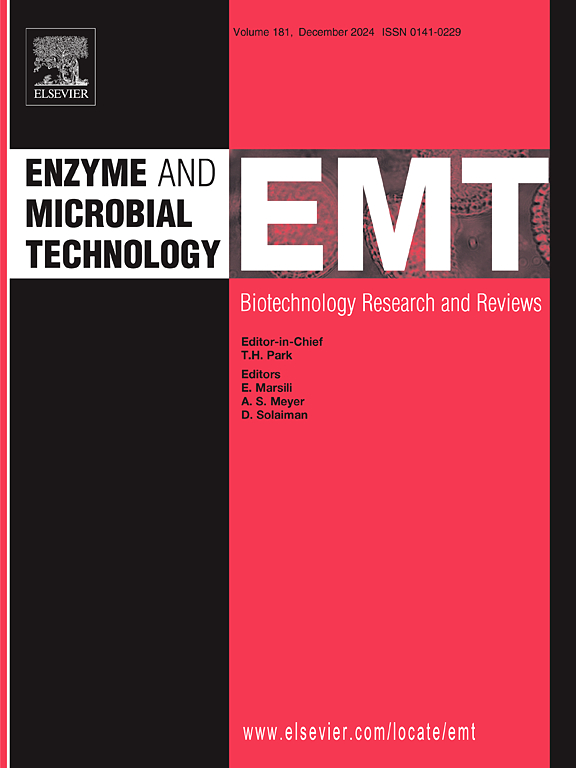超支化聚合物交联漆酶聚集体用于醇的高效有氧氧化
IF 3.7
3区 生物学
Q2 BIOTECHNOLOGY & APPLIED MICROBIOLOGY
引用次数: 0
摘要
交联酶聚合体(CLEA)技术是一种简单、便捷的酶的无载体固定化方法。然而,酶聚集体的不规则空隙限制了使用戊二醛等规则交联剂控制交联过程。为了克服这一限制,我们开发了一种简单的策略来制备超支化聚合物交联漆酶聚集体(HPCLEAs)。超支化聚合物是在漆酶聚集体的空隙中生成的,通过超支化聚合物形成的原位交联为自适应空隙交联过程提供了途径。这些hpclea形状不规则,尺寸为~ 2-10 μm。在优化的制备条件下,其初始活性保持在99 %。2,2,6,6-四甲基-1-胡椒啶- n -氧(TEMPO)的进一步掺入促进了漆酶和TEMPO之间的接近,导致醇的有效有氧氧化。此外,这些催化剂可以很容易地回收和重复使用四次,而活性损失很小。这一策略为化学酶催化中酶和分子催化剂的合理设计和共固定开辟了一条途径。本文章由计算机程序翻译,如有差异,请以英文原文为准。
Hyperbranched polymer-crosslinked laccase aggregates for efficient aerobic oxidation of alcohols
The crosslinked enzyme aggregate (CLEA) technique has been developed as an easy and convenient strategy for carrier-free immobilization of enzymes. However, the irregular voids of enzyme aggregates limit the controlled crosslinking process by using regular crosslinkers such as glutaraldehyde. To overcome this limitation, here we have developed a simple strategy for the preparation of hyperbranched polymer-crosslinked laccase aggregates (HPCLEAs). Hyperbranched polymers were generated in voids of laccase aggregates, and the in situ crosslinking through the formation of hyperbranched polymers provided access to the void-adaptive crosslinking process. These HPCLEAs had irregular shapes and sizes of ∼2–10 μm. 99 % of the initial activity was maintained under the optimized preparation conditions. Further incorporation of 2,2,6,6-tetramethyl-1-piperidine-N-oxyl (TEMPO) facilitated the proximity between laccase and TEMPO, resulting in efficient aerobic oxidation of alcohols. Additionally, these catalysts could be easily recovered and reused four times with a slight loss of activity. This strategy may open an avenue for the rational design and co-immobilization of enzyme and molecular catalysts used for chemoenzymatic catalysis.
求助全文
通过发布文献求助,成功后即可免费获取论文全文。
去求助
来源期刊

Enzyme and Microbial Technology
生物-生物工程与应用微生物
CiteScore
7.60
自引率
5.90%
发文量
142
审稿时长
38 days
期刊介绍:
Enzyme and Microbial Technology is an international, peer-reviewed journal publishing original research and reviews, of biotechnological significance and novelty, on basic and applied aspects of the science and technology of processes involving the use of enzymes, micro-organisms, animal cells and plant cells.
We especially encourage submissions on:
Biocatalysis and the use of Directed Evolution in Synthetic Biology and Biotechnology
Biotechnological Production of New Bioactive Molecules, Biomaterials, Biopharmaceuticals, and Biofuels
New Imaging Techniques and Biosensors, especially as applicable to Healthcare and Systems Biology
New Biotechnological Approaches in Genomics, Proteomics and Metabolomics
Metabolic Engineering, Biomolecular Engineering and Nanobiotechnology
Manuscripts which report isolation, purification, immobilization or utilization of organisms or enzymes which are already well-described in the literature are not suitable for publication in EMT, unless their primary purpose is to report significant new findings or approaches which are of broad biotechnological importance. Similarly, manuscripts which report optimization studies on well-established processes are inappropriate. EMT does not accept papers dealing with mathematical modeling unless they report significant, new experimental data.
 求助内容:
求助内容: 应助结果提醒方式:
应助结果提醒方式:


